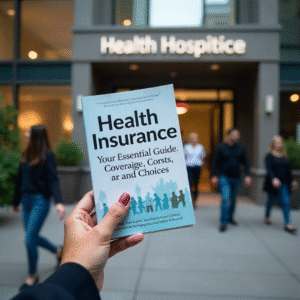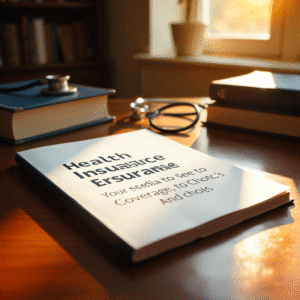Introduction
Welcome to Info Vistaa, where we empower you with the knowledge you need for informed decisions about health insurance. In a world where medical expenses can skyrocket, understanding health insurance is not just important; it’s essential. This guide will break down everything you need to know about health insurance, ensuring you’re equipped to navigate your options confidently. Whether you’re a young professional, a parent, or someone looking to secure their health future, this comprehensive resource will serve as your go-to guide.

What is Health Insurance?
Health insurance is a contract between you and an insurance provider that pays for a portion of your medical expenses. It’s a safety net that protects you from exorbitant costs associated with unexpected health issues. Whether it’s routine check-ups or emergency surgeries, health insurance can significantly reduce the financial burden on you and your family.
In essence, health insurance allows individuals to share the risk of medical expenses across a larger group, making it more affordable for everyone involved. By paying a monthly premium, you ensure that when the unexpected happens—be it an accident, illness, or routine procedure—you’re not left to bear the full financial brunt.
Why Health Insurance Matters
- Financial Protection: Health insurance protects you from high medical costs. Without it, a single hospital visit can lead to crippling debt. For instance, an emergency room visit can easily cost thousands of dollars, depending on the treatment required.
- Access to Quality Care: Insured individuals are more likely to seek preventive care, ensuring early detection of potential health issues. Regular check-ups and screenings can catch diseases early, significantly improving outcomes and reducing long-term costs.
- Peace of Mind: Knowing you have coverage allows you to focus on your health rather than worrying about your finances. This peace of mind is invaluable, especially during stressful times.
- Legal Requirement: In many places, having health insurance is not just advisable; it’s a legal requirement. Understanding your obligations can help you avoid penalties and ensure compliance with the law.

Types of Health Insurance Plans
Understanding the different types of health insurance plans is crucial. Here’s a breakdown:
1. Health Maintenance Organization (HMO)
- Overview: Requires members to choose a primary care physician (PCP) and get referrals for specialists.
- Pros: Lower premiums and out-of-pocket costs, making it a budget-friendly option for many families.
- Cons: Limited provider options; you must stay within the network for coverage, which can be restrictive.
2. Preferred Provider Organization (PPO)
- Overview: Offers more flexibility in choosing healthcare providers without a referral.
- Pros: Wider network of doctors and specialists, allowing for greater choice and convenience.
- Cons: Higher premiums; you pay more for the flexibility of seeing out-of-network providers.
3. Exclusive Provider Organization (EPO)
- Overview: Similar to PPOs but does not cover any out-of-network care except in emergencies.
- Pros: Lower costs than PPOs, which can make them appealing for those who don’t need frequent specialist visits.
- Cons: Limited to network providers, which may not include your preferred doctors.
4. Point of Service (POS)
- Overview: Combines features of HMO and PPO plans, allowing members to choose between in-network and out-of-network providers.
- Pros: Flexibility in choosing providers, which can be beneficial if you have specific healthcare needs.
- Cons: Requires referrals for specialists, which can be a hassle.
5. High Deductible Health Plan (HDHP)
- Overview: Features higher deductibles and lower premiums; often paired with Health Savings Accounts (HSAs).
- Pros: Lower monthly costs and the ability to save for medical expenses tax-free with an HSA.
- Cons: Higher out-of-pocket expenses before coverage kicks in, which can be a barrier for some.
Key Terms You Should Know
To navigate the world of health insurance effectively, familiarize yourself with these key terms:
- Premium: The monthly amount you pay for your health insurance plan. This is your ticket to coverage, so understanding this cost is crucial.
- Deductible: The amount you pay out-of-pocket before your insurance starts to cover costs. Higher deductibles generally mean lower premiums, but they can lead to significant expenses if you require extensive medical care.
- Copayment: A fixed amount you pay for a specific service, like a doctor’s visit. This is often a small fee, but it adds up over time.
- Coinsurance: The percentage of costs you pay after meeting your deductible. For example, if your coinsurance is 20%, you’ll pay 20% of the cost of services after your deductible is met.
- Out-of-Pocket Maximum: The most you will have to pay for covered services in a plan year. After you reach this limit, your insurance will cover 100% of your medical expenses.

How to Choose the Right Health Insurance Plan
Choosing the right health insurance plan can be daunting, but following these steps can simplify the process:
- Assess Your Needs: Consider your health status, family medical history, and any ongoing treatments. If you have chronic conditions or expect to need frequent care, prioritize plans with lower deductibles.
- Compare Costs: Look beyond premiums. Evaluate deductibles, copayments, and out-of-pocket maximums. A plan with a low premium might not be the best choice if it has a high deductible.
- Check Provider Networks: Ensure your preferred doctors and hospitals are included in the plan’s network. Use the insurance provider’s website to verify that your necessary providers are included.
- Consider Additional Benefits: Look for plans offering wellness programs, telehealth services, or mental health support. These added benefits can significantly enhance your overall care experience.
- Read Reviews and Ratings: Research the insurance company’s reputation for customer service and claims handling. Websites like Consumer Reports or the Better Business Bureau can provide valuable insights.
- Seek Professional Advice: If you’re unsure, consider consulting with an insurance broker. They can help you navigate your options and find the best plan for your needs.
The Cost of Health Insurance
The cost of health insurance varies widely based on several factors:
- Age: Older individuals typically pay higher premiums due to increased health risks.
- Location: Costs can vary by state and even by county, influenced by local healthcare costs and regulations.
- Type of Plan: HMO, PPO, and other plan types come with different cost structures. Generally, more flexible plans like PPOs have higher premiums.
- Income: Lower-income individuals may qualify for subsidies through the Affordable Care Act (ACA), making coverage more affordable.
Understanding the Financial Breakdown
- Monthly Premiums: This is the fixed cost you pay each month. It’s essential to include this in your budget.
- Annual Deductibles: This is the amount you need to pay out of pocket before your insurance starts to cover expenses. High-deductible plans may save you money monthly but can lead to high costs if you need care.
- Cost-Sharing: This includes copayments and coinsurance, which can add up quickly if you require frequent medical attention.
- Out-of-Pocket Maximums: Understanding this cap can provide peace of mind, knowing that once you hit this amount, your insurance will cover 100% of your medical costs for the rest of the year.
The Importance of Preventive Care
Preventive care is essential in maintaining your health and can save you money in the long run. Health insurance plans often cover preventive services at no cost to you. This includes:
- Annual Check-Ups: Regular visits to your primary care physician can help catch health issues early.
- Vaccinations: Stay up to date with immunizations to prevent serious diseases.
- Screenings: Regular screenings for conditions such as high blood pressure, diabetes, and cancer can lead to early detection and better outcomes.
The Role of Health Savings Accounts (HSAs)
Health Savings Accounts (HSAs) are a valuable tool for those enrolled in high deductible health plans. Here’s how they work:
- Tax Benefits: Contributions to an HSA are made with pre-tax dollars, reducing your taxable income.
- Long-Term Savings: Funds in your HSA roll over year after year, allowing you to save for future medical expenses.
- Qualified Expenses: You can use HSA funds for a wide range of qualified medical expenses, including deductibles, copayments, and certain over-the-counter medications.

Navigating Open Enrollment
Open enrollment is the period when you can sign up for or make changes to your health insurance plan. Here’s what you need to know:
Key Dates
- Annual Enrollment Period: Typically occurs once a year, usually in the fall. Be sure to mark your calendar!
- Special Enrollment Periods: If you experience a qualifying life event (such as marriage, birth of a child, or loss of other coverage), you may qualify for a special enrollment period.
Tips for Open Enrollment
- Review Your Current Plan: Assess whether your existing plan still meets your needs. Changes in health status or family circumstances may require a different plan.
- Compare New Options: Don’t just renew your current plan; explore new options that may offer better coverage or lower costs.
- Understand Your Eligibility for Subsidies: If your income has changed, you may be eligible for financial assistance under the ACA.
- Ask Questions: Don’t hesitate to reach out to insurance representatives or brokers for clarification on any confusing terms or options.
Frequently Asked Questions (FAQs)
1. What is the best type of health insurance for young adults?
For young adults, a PPO or HDHP might be ideal due to flexibility and lower premiums. These plans allow you to manage costs while still accessing necessary care.
2. How can I save on health insurance?
Consider shopping around during open enrollment, exploring employer-sponsored plans, or seeking government subsidies. Additionally, utilizing preventive care can help avoid costly treatments later.
3. What happens if I don’t have health insurance?
Without health insurance, you may face high medical bills, and you could be at risk for financial hardship in case of a medical emergency. Some states also impose penalties for not having coverage.
4. Can I change my health insurance plan?
Yes, you can change your plan during open enrollment periods or if you experience a qualifying life event, such as marriage or moving to a new state.
5. What is a Health Savings Account (HSA)?
An HSA is a tax-advantaged savings account that allows you to pay for qualified medical expenses using pre-tax dollars. It’s a great way to save for future healthcare costs.
6. How do I file a claim with my health insurance?
Filing a claim typically involves submitting a form along with documentation of your medical expenses. Check with your insurance provider for specific instructions.
7. Are there any health insurance plans that cover alternative medicine?
Some plans offer coverage for alternative treatments, such as acupuncture or chiropractic care. It’s essential to review the plan details to understand what is covered.
Conclusion
Health insurance is not just a safety net; it’s a vital component of your financial and physical well-being. By understanding your options and knowing how to choose the right plan, you can protect yourself and your family from unexpected medical costs. Don’t wait until it’s too late—take charge of your health insurance journey today!


1 thought on “Health Insurance: Your Essential Guide to Coverage, Costs, and Choices”